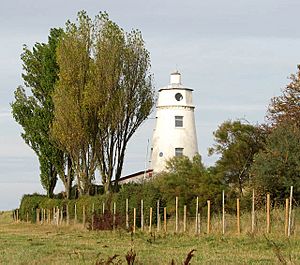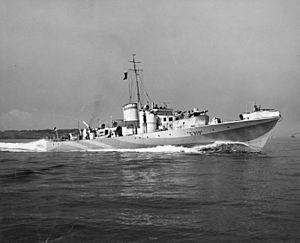Peter Scott facts for kids
Quick facts for kids
Peter Scott
|
|
|---|---|
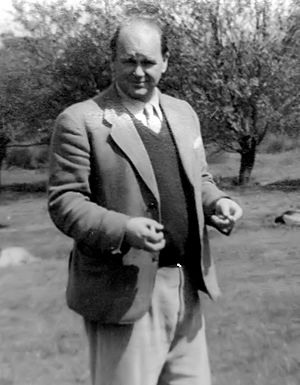
Scott in 1954
|
|
| Born |
Peter Markham Scott
14 September 1909 London, England
|
| Died | 29 August 1989 (aged 79) Bristol, England
|
| Monuments | Statue of Sir Peter Scott at the WWT London Wetland Centre, busts at each of the Wildfowl & Wetlands Trust centres |
| Occupation | Ornithologist, conservationist, aviculturist, painter, naval officer, broadcaster |
| Known for | Conservation, WWT Slimbridge, painting, WWF |
| Spouse(s) |
Philippa Talbot-Ponsonby
(m. 1951) |
| Children | 3 |
| Parent(s) | Robert Falcon Scott Kathleen Bruce |
Sir Peter Markham Scott (1909–1989) was a famous British expert on birds, a person who worked to protect nature, a painter, a naval officer, a broadcaster, and a sportsman. He was the only child of the famous Antarctic explorer Robert Falcon Scott. From a young age, Peter Scott loved watching and raising wild birds.
He started the Wildfowl & Wetlands Trust in Slimbridge in 1946. He also helped create the World Wide Fund for Nature (WWF) and even designed its well-known panda logo. Peter Scott loved sailing from a young age and later took up gliding. He won a bronze medal in sailing at the 1936 Summer Olympics for the UK team. In 1973, he was made a knight for his important work in protecting wild animals. He also received top awards for his conservation efforts.
Contents
Peter Scott's Early Life
Peter Scott was born in London on September 14, 1909. His father was the famous Antarctic explorer Robert Falcon Scott, and his mother was the sculptor Kathleen Bruce. Peter was only two years old when his father died during his Antarctic expedition. In a final letter to his wife, Robert Scott wrote, "make the boy interested in natural history if you can; it is better than games."
Peter was named after Sir Clements Markham, who guided his father's polar trips. J. M. Barrie, the creator of Peter Pan, was also one of his godfathers. In 1922, his mother remarried Hilton Young, who became Peter's stepfather. Peter later had a half-brother named Wayland Young.
Peter went to Oundle School and then Trinity College, Cambridge. He first studied science but later changed to the History of Art, graduating in 1931. He also studied art in Munich, Germany, and at the Royal Academy Schools in London. He became well-known for painting wildlife, especially birds. His first art show was in London in 1933.
| Olympic medal record | ||
|---|---|---|
| Men's sailing | ||
| Bronze | 1936 Berlin/Kiel | Monotype class |
Because his family was wealthy, Peter could follow his many interests. These included art, wildlife, and various sports like hunting wild birds, sailing, gliding, and ice skating. He represented Great Britain at the 1936 Summer Olympics in sailing and won a bronze medal. He also helped design a special harness for sailing, now called a trapeze, which helped him win a race in 1938.
Peter Scott's Role in World War II
During the Second World War, Peter Scott served in the Royal Navy Volunteer Reserve. As a Sub-Lieutenant, he helped rescue wounded soldiers from Saint-Valery-en-Caux in France in 1940. This was one of the last rescues of British troops from that port before it was taken by the enemy.
He then served on destroyer ships in the North Atlantic. Later, he commanded a squadron of Steam Gun Boats, fighting against German boats in the English Channel.
Scott is also known for creating a special ship camouflage design for ships in the Western Approaches (the North Atlantic). This design helped hide the ships. In 1940, he had his own destroyer, HMS Broke (D83), painted with his experimental camouflage. One side was blue-grey with white in shaded areas to blend in. The other side used "bright pale colours" to make the ship harder to see at night. He believed that being invisible at night was the most important goal for camouflage.
By May 1941, all ships in the North Atlantic were ordered to use Scott's camouflage. It was so effective that some British ships, including HMS Broke, accidentally collided with each other because they were so hard to see! Tests showed that a white ship could get much closer to an enemy before being spotted compared to a black ship.
Peter Scott's Post-War Life and Conservation Work
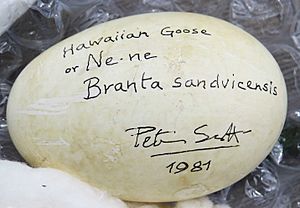
After the war, in 1946, Peter Scott started the Severn Wildfowl Trust, which is now called the Wildfowl and Wetlands Trust. Its main center is at WWT Slimbridge in Gloucestershire. Here, he began a special program to breed birds in captivity. This program famously saved the nene or Hawaiian goose from extinction in the 1950s.
In the following years, he led bird-watching trips all over the world. He also became a popular television personality, teaching people about wildfowl (water birds) and wetlands (areas of land covered by water).
His BBC nature show, Look, ran from 1955 to 1969 and made him a household name. It included the first BBC nature film shown in color, The Private Life of the Kingfisher (1968), which he narrated. He wrote and drew pictures for many books about nature, including his own life story, The Eye of the Wind (1961). He also appeared on BBC radio's Children's Hour in a series called "Nature Parliament."
Scott started gliding in 1956 and became a British champion in 1963. He was the chairman of the British Gliding Association for two years starting in 1968. He also got Prince Philip interested in gliding.
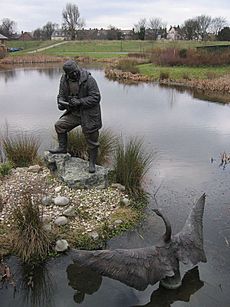
As a member of the Species Survival Commission, he helped create the Red Data books. These books list species of animals and plants that are in danger of disappearing.
Peter Scott was a founder of the World Wide Fund for Nature (WWF) and designed its famous panda logo. His important work in conservation also helped change how the International Whaling Commission worked. He also inspired the signing of the Antarctic Treaty after visiting his father's base in Antarctica.
He died from a heart attack on August 29, 1989, in Bristol, just two weeks before his 80th birthday.
Documentaries About Peter Scott
Peter Scott narrated Wild Wings, a British short film from 1966. In 1967, this film won an Oscar for Best Short Subject.
In 1986, a TV special called Interest the Boy in Nature was made about Scott. It featured famous people like Konrad Lorenz, Prince Philip, David Attenborough, and Gerald Durrell.
In 1996, the BBC made a major documentary about Scott's life and work called In the Eye of the Wind. It was filmed across three continents and was a tribute to Scott and the Wildfowl and Wetland Trust.
In 2004, Peter Scott and Sir David Attenborough were featured together in a BBC Two series called The Way We Went Wild. They were described as being very important in shaping how people in Britain and around the world view wildlife.
Another BBC Four documentary about his life, Peter Scott – A Passion for Nature, was produced in 2006.
Peter Scott and the Loch Ness Monster
In 1962, Peter Scott helped start the Loch Ness Phenomena Investigation Bureau. This group investigated sightings of the Loch Ness Monster. In 1975, Scott even suggested a scientific name for the monster, Nessiteras rhombopteryx. He did this based on a blurry underwater photo of what looked like a fin. His idea was that if it had a scientific name, it could be listed as an endangered species.
The name he chose came from Ancient Greek words meaning "monster of Ness with diamond-shaped fin." However, a newspaper later pointed out that the letters in the name could be rearranged to spell "Monster hoax by Sir Peter S." Someone else then noted that the letters could also spell, "Yes, both pix are monsters, R."
Peter Scott's Family Life
Scott married the writer Elizabeth Jane Howard in 1942. They had a daughter named Nicola a year later. Elizabeth left Scott in 1946, and they divorced in 1951.
In 1951, Scott married his assistant, Philippa Talbot-Ponsonby, while they were on a trip to Iceland. They were looking for where the pink-footed goose breeds. Their daughter, Dafila, was born later that year. Dafila also became an artist, painting birds. Their son, Falcon, was born in 1954.
Awards and Recognitions
Peter Scott received many awards and honors for his service and work.
- In 1941, he was mentioned in official reports for bravely rescuing survivors from a burning ship during the war.
- In 1942, he was mentioned again for his bravery and skill during an attack on Dieppe.
- In 1943, he received the Distinguished Service Cross (DSC) for his skill and bravery in fighting enemy forces.
- He was made a Member of the Order of the British Empire (MBE) in 1942.
- He was promoted to Commander of the Order of the British Empire (CBE) in 1953.
- Queen Elizabeth II made him a knight in 1973.
- In 1987, he was given the Order of the Companions of Honour (CH) for his great contributions to conservation.
- Also in 1987, he became a Fellow of the Royal Society, a very important scientific group.
Peter Scott's Legacy
- The fish Cirrhilabrus scottorum was named after Peter and Philippa Scott because of their "great contribution in nature conservation."
- The Peter Scott Walk is a path that goes along the River Nene and The Wash. It starts near Scott's lighthouse in Lincolnshire and goes to King's Lynn.
- The Sir Peter Scott National Park is in Jamnagar, India. Jamnagar also has a Sir Peter Scott Bird Hospital. These places were created because of the friendship between Peter Scott and Jam Sahib, the ruler of Jamnagar.
Images for kids
See Also
 In Spanish: Peter Scott para niños
In Spanish: Peter Scott para niños


